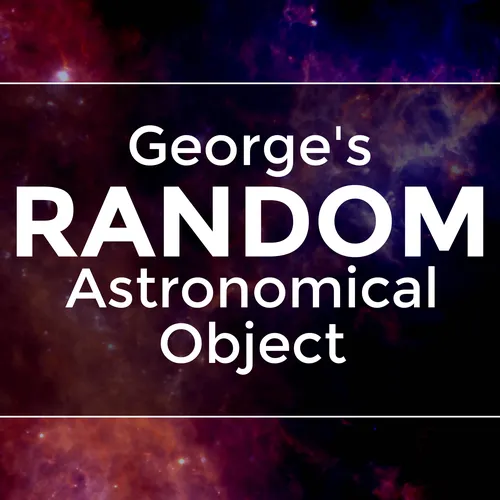
George's Random Astronomical Object
George's Random Astronomical Object is a biweekly astronomy podcast featuring science discussions about astronomical objects at randomly selected locations in the sky. The wide range of topics discussed in the show include stars, variable stars, variable variable stars, supermassive black holes, ultracool dwarf stars, exoplanets, howler monkeys, infrared radiation, acronyms, more acronyms, starbursts, measurements of less than 12 parsecs, jellyfish galaxies, diffuse ionized gas, and general overall weirdness.
- Update frequency
- every 14 days
- Average duration
- 10 minutes
- Episodes
- 157
- Years Active
- 2019 - 2025

Object 137: The Bedtime Story of the Black Hole that was Too Large for its Galaxy
The elliptical galaxy NGC 4291 contains a supermassive black hole that is unusually massive in comparison to the rest of the galaxy.
00:08:17 |
Mon 11 Nov 2024

Object 136: Barium
HD 11397 is one of very few Sun-like stars that might seem ordinary but actually contain abnormally large amounts of heavy elements, most notably barium, that they could not have formed themselves.
00:10:43 |
Mon 28 Oct 2024

Object 135: Feedback Time
NGC 3801 is one of the very few nearby galaxies where astronomers can see jets from an active galactic nucleus disrupting star formation in the galaxy in a process known as feedback.
00:09:01 |
Mon 14 Oct 2024

Object 134: Not Dead Yet
The star at the center of the planetary nebula NGC 7094 is almost but not quite a white dwarf, making it a rather unusual object for astronomers to look at.
00:07:24 |
Mon 30 Sep 2024

Object 133: Strong Arm Tactics
One of the spiral arms in the galaxy NGC 3110 is producing unusually huge amounts of new stars as well as unusually huge amounts of infrared emission.
00:09:45 |
Mon 16 Sep 2024

Object 132: I Need a 2002 Pop Culture Reference
The radio source PMN J0134-0931 created a lot of excitement in 2002 when people discovered that it was a quasar gravitationally lensed by another galaxy in front of it, they were really excited.
00:11:21 |
Mon 02 Sep 2024

Object 131: Get To Know Your Ultrafaint Neighbors
Hydrus I is a very small, ultrafaint dwarf galaxy orbiting the Milky Way that was accidentally (or, to use the technical term, serendipitously) found by the Dark Energy Survey.
00:09:45 |
Mon 19 Aug 2024

Object 130: Putting It All Together
NGC 4261 was made famous when Hubble Space Telescope observations in the 1990s showed that this elliptical galaxy contains a supermassive black hole.
00:07:46 |
Mon 05 Aug 2024

Object 129: Rinky-Dink
The very small Pyxis Cluster orbits the Milky Way in such an extremely extended orbit that it travels further away than many of the dwarf galaxies orbiting our galaxy.
00:09:15 |
Mon 22 Jul 2024

Object 128: The Dwarf Living Inside the Bridge
The NGC 6221/NGC 6215 Group of galaxies contains a bridge-like structure of hydrogen gas connecting the two spiral galaxies within the group as well as a dwarf galaxy that looks like it formed within…
00:06:58 |
Mon 08 Jul 2024

Object 127: The Nebraska Blue Straggler Special
The open cluster NGC 188 is peculiar not only because it is very old for an open cluster but also because it contains an unusual number of blue stars for a cluster of its age.
00:12:59 |
Mon 24 Jun 2024

Object 126: Do Not Mention Exoplanet b Again
HD 181433 has three exoplanets, two of which are gas giants with very unusually elongated orbits that have been very challenging to properly measure.
00:10:10 |
Mon 10 Jun 2024

Object 125: The Business Form Variable Star System
HR 1099 (also known as V711 Tauri) was instrumental in showing that magnetic fields play a major role in causing the variability of stars within the RS CVn class of variable star systems.
00:07:39 |
Mon 27 May 2024

Object 124: 6 > 2
Most people would associate Castor with Pollux, which are the two brightest stars in the constellation Gemini, but Castor by itself is very interesting because it is actually a very complex system co…
00:11:16 |
Mon 13 May 2024

Object 123: More Dampness
The quasar QSO 1331+170 is best known for having a darker galaxy in front of it that is absorbing its light.
00:11:09 |
Mon 29 Apr 2024

Object 122: Wait For It...
The cluster of galaxies MACS J1149.5+2223 is so massive that it has gravitationally bent (or lensed) the light from multiple things behind it, including one of the most distant galaxies in the univer…
00:12:57 |
Mon 15 Apr 2024

Object 121: Can You Find the Supermassive Black Hole?
NGC 34 (also known as NGC 17) is a chaotic-looking galaxy that formed from two smaller galaxies merging together, and it is a place where astronomers have easily found lots of stars forming in a star…
00:08:53 |
Mon 01 Apr 2024

Object 120: A Possible Source of the Cosmic Rays that Gave the Fantastic Four Their Superpowers
The Monogem Ring, which is one of the largest sources of X-rays in the Earth's sky, was created by a supernova explosion about 86000 years ago, and the core of the star that exploded has been identif…
00:11:14 |
Mon 18 Mar 2024

Object 119: Alpha Table
Even though Alpha Mensae is in one of the faintest and dumbest constellations in the sky, it's an intriguing star system because it is very close to the Earth, because one of the stars is very Sun-li…
00:08:49 |
Mon 04 Mar 2024

Object 118: The Golden Standard
The Type Ia supernova SN 2005cf was observed at multiple wavelengths for three months after its appearance, allowing astronomers to create templates of its spectrum that could be used to measure dist…
00:10:50 |
Mon 19 Feb 2024
Disclaimer: The podcast and artwork embedded on this page are the property of George Bendo. This content is not affiliated with or endorsed by eachpod.com.